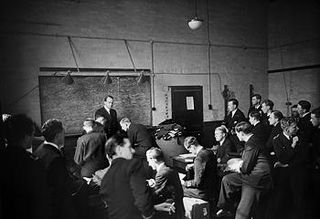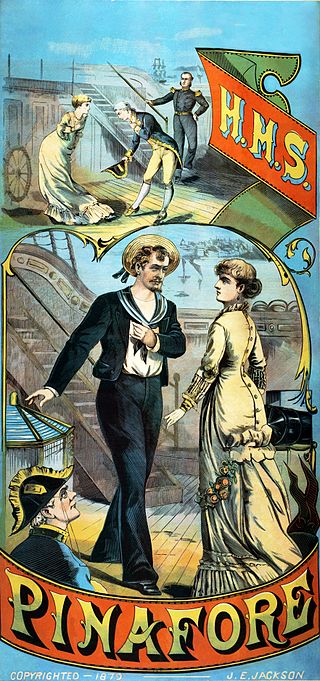
H.M.S. Pinafore; or, The Lass That Loved a Sailor is a comic opera in two acts, with music by Arthur Sullivan and a libretto by W. S. Gilbert. It opened at the Opera Comique in London on 25 May 1878, and ran for 571 performances, which was the second-longest run of any musical theatre piece up to that time. H.M.S. Pinafore was Gilbert and Sullivan's fourth operatic collaboration and their first international sensation.

Mutiny is a revolt among a group of people to oppose, change, or remove superiors or their orders. The term is commonly used for insubordination by members of the military against an officer or superior, but it can also sometimes mean any type of rebellion against any force. Mutiny does not necessarily need to refer to a military force and can describe a political, economic, or power structure in which subordinates defy superiors.
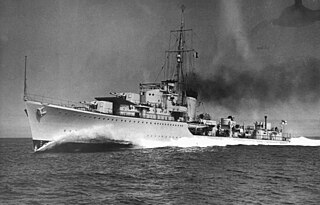
HMS Kelly was a K-class destroyer of the British Royal Navy, and flotilla leader of her class. She served through the early years of the Second World War; in Home Waters, off Norway and in the Mediterranean. Throughout her service, Kelly was commanded by Lord Louis Mountbatten, as commander of the 5th Destroyer Flotilla. She was lost in action in 1941 during the Battle of Crete.

HMS Illustrious was a light aircraft carrier of the Royal Navy and the second of three Invincible-class ships constructed in the late 1970s and early 1980s. She was the fifth warship and second aircraft carrier to bear the name Illustrious, and was affectionately known to her crew as "Lusty". In 1982, the conflict in the Falklands necessitated that Illustrious be completed and rushed south to join her sister ship HMS Invincible and the veteran carrier HMS Hermes. To this end, she was brought forward by three months for completion at Swan Hunter Shipyard, then commissioned on 20 June 1982 at sea en route to Portsmouth Dockyard to take on board extra stores and crew. She arrived in the Falklands to relieve Invincible on 28 August 1982 in a steam past. Returning to the United Kingdom, she was not formally commissioned into the fleet until 20 March 1983. After her South Atlantic deployment, she was deployed on Operation Southern Watch in Iraq, then Operation Deny Flight in Bosnia during the 1990s and Operation Palliser in Sierra Leone in 2000. An extensive re-fit during 2002 prevented her from involvement in the 2003 Iraq War, but she was returned to service in time to assist British citizens trapped by the 2006 Lebanon War.

HMS Duke of Wellington was a 131-gun first-rate ship of the line of the Royal Navy. Launched in 1852, she was symptomatic of an era of rapid technological change in the navy, being powered both by sail and steam. An early steam-powered ship, she was still fitted with towering masts and trim square-set yards, and was the flagship of Sir Charles Napier.
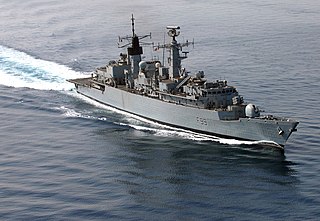
HMS Cornwall was a Batch 3 Type 22 frigate of the Royal Navy. She was the first Batch 3 to be built, and the last to decommissioned. Cornwall was based at HMNB Devonport in Devon, England, part of the Devonport Flotilla.

HMS Invincible was a Royal Navy Audacious-class ironclad battleship. She was built at the Napier shipyard and completed in 1870. Completed just 10 years after HMS Warrior, she still carried sails as well as a steam engine.

HMS Challenger was a Pearl-class corvette of the Royal Navy launched on 13 February 1858 at the Woolwich Dockyard. She served the flagship of the Australia Station between 1866 and 1870.

HMS Active was a Volage-class corvette built for the Royal Navy in the late 1860s. Launched in 1869, she entered service in 1873, and was the commodore's ship on the Cape of Good Hope and West Africa Station. Her crew served ashore in both the Third Anglo-Ashanti and Zulu Wars. From 1885 to 1898, the ship was the flagship of the Training Squadron. Active was sold for scrap in 1906.

HMS Alexandra was a central battery ironclad of the Victorian Royal Navy, whose seagoing career was from 1877 to 1900. She spent much of her career as a flagship, and took part in operations to deter the Russian Empire's aggression against the Ottoman Empire in 1878 and the bombardment of Alexandria in 1882. She was affectionately known by her crew as Old Alex.

The Duncan class of 101-gun two-decker steam line-of-battle ships are considered by Professor Andrew Lambert to have been the "final statement of the British design progress" for steam two-deckers. The class consisted of HMS Duncan and HMS Gibraltar. The Bulwark class had identical hulls. HMS Gibraltar was the last wooden steam line-of-battleship to commission as a private ship in the Royal Navy.

Admiral Sir George Greville Wellesley was a Royal Navy officer. As a junior officer he took part in the capture of Acre during the Oriental Crisis in 1840 and, as Captain of HMS Cornwallis in the Baltic Fleet, he took part in the Bombardment of Sveaborg in August 1855 during the Crimean War. He went on to be Commander-in-Chief of the North America and West Indies Station and then Commander-in-Chief of the Channel Squadron but was relieved of the latter post by a court-martial after an incident in which an armoured frigate, which had been under his command at the time, ran aground at Pearl Rock off Gibraltar in July 1871. He was appointed First Naval Lord in November 1877 and in that capacity he secured a considerable increase in naval construction, for example on the Colossus-class battleships, although some of these ships were of doubtful quality.

HMS Terrible was when designed the largest steam-powered wooden paddle wheel frigate built for the Royal Navy.

HMS Victory is a 104-gun first-rate ship of the line of the Royal Navy. She was ordered in 1758, laid down in 1759, and launched in 1765. With 245 years of service as of 2023, she is the world's oldest naval vessel still in commission.
HMS Emerald was an Emerald-class corvette, of the Royal Navy, built at the Pembroke Dockyard and launched on 18 August 1876.

James Roland MacLaren was a Scottish actor and playwright.

HMS Calpe was a British Royal Navy Type II Hunt-class destroyer escort. Built as a result of the outbreak of World War II, Calpe escorted convoys during the war and participated in the Dieppe Raid. Calpe is an old name for Gibraltar. Collaborating with USS Wainwright on 13 December 1943, she assisted in the sinking of German U-boat U-593. Calpe was loaned and then sold to the Danish Navy, remaining active until she was scrapped in Sweden in 1966.
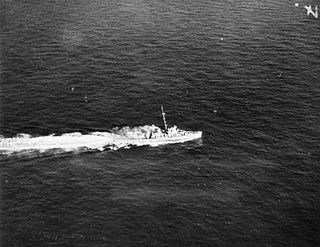
The second HMS Moorsom (K567) was a British Captain-class frigate of the Royal Navy in commission during World War II. Originally constructed as the United States Navy Evarts-class destroyer escort DE-522, she served in the Royal Navy from 1943 to 1945.
HMS Triton was a paddle steamer which was used by the Royal Navy for many years as a survey ship. The ship was commissioned by Staff Commander Thomas Henry Tizard, who had started a survey of the coast of England in 1879 in HMS Porcupine, which was sold after HMS Triton became available for use. Tizard continued this work until 1891.












